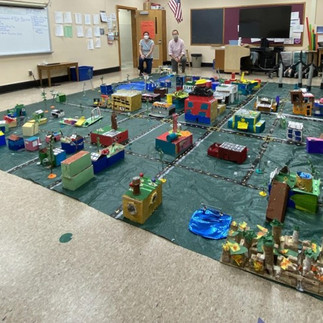At 1000 Friends of Wisconsin, we believe that people of all ages can benefit from learning about sustainable land use; it’s not just for grown-ups! When the opportunity came to be a mentor for Terrace Town, an event for Dane County elementary students hosted by the Monona Terrace Convention Center in downtown Madison, I (Susan) jumped at the chance to sign up. It may sound cliché, but engaging young people in conversations and hands-on activities about sustainable community design is critical to the future. Plus, kids always come up with creative and interesting ideas, and it sounded like fun.
What is Terrace Town?
Terrace Town occurs every other year and introduces Dane County elementary students to architecture, sustainable design, and city planning. Volunteers partner with classroom teachers to share expertise in planning, architecture, design, and engineering. Classrooms use their newfound knowledge to design and build model cities, which are installed in the Monona Terrace Exhibition Hall for public viewing.

Students prepare to set up their model cities in the Monona Terrace Exhibition Hall before the public event ca. 2016. Image courtesy of Monona Terrace.
COVID Impacts
The last Terrace Town was held in early 2020, just weeks before COVID-19 brought everything to a screeching halt. Unfortunately, due to the spread of the Omicron variant and continuing pandemic, all in-person activities related to Terrace Town were canceled for safety reasons in 2022. Though the number of participating schools was down overall, several hundred students from 8 schools across Dane County were still able to experience Terrace Town. The programming and curriculum were adapted for virtual sessions with volunteers. Classrooms built model cities in their respective schools and shared their work through photos, videos, writing assignments, and Zoom presentations.
Terrace Town at Crestwood
Crestwood Elementary School on the west side of Madison has a long history of participating in Terrace Town, and it is an event that students look forward to when they are in 2nd or 3rd grade. This year, five volunteers (myself included) were partnered with third grade classes to teach them about architecture, sustainable buildings, active transportation and complete streets, and green infrastructure. Veteran teachers Connie Allen and Ben Kaker organized Zoom meetings and helped prepare the students with vocabulary and other concepts we provided for them. I focused on different modes of transportation and Complete Streets.
Walking Field Trip
Because of Covid restrictions, volunteers were not allowed inside classrooms for in-person lessons or demonstrations. However, in mid-February I was able to organize a short walking field trip with another volunteer, Steve Whayland, who works as a civil engineer. After recess, all the third graders met us on the sidewalk across from the school. We walked down the hill to a small public green space, and the kids circled up so everyone could make some observations about the infrastructure around us. We talked about what makes a street safe for biking, how to design crosswalks, where the water drains when there is a storm, and where utilities go. Honestly, it might not have been the most riveting discussion for 8-year-olds, most of whom were distracted with playing in the snow on the ground. However, it was the first time in two years these kids had been on a field trip of ANY kind. If nothing else, the neighborhood walk meant an extra 30 minutes of fresh air for third grade students and staff, which was welcome indeed.

Image description: Crestwood students and staff head back to the school after a neighborhood walk to look at street design and infrastructure.
Student work
The most exciting part of Terrace Town is of course seeing what the kids come up with. Please enjoy this photo gallery of student work that the teachers shared with parents and volunteers during a Zoom presentation. Some examples of student writing are included as well. These represent just a sample of what was shared. We just may have some future architects, planners, and engineers in the making!
Here are a few examples of street design. Students were cognizant of different modes of transportation on the streets. Notice the coffee shop named "Dr. Caffeine" in the photo on the right!
Here are some designs for green homes and a pet store. There were so many creative ideas!
Terrace Town structures from left to right: an animal bridge, an all abilities playground, a nature center.
When it came time to build Terrace Town, a tarp with a duct tape street grid was spread out on the floor of a large classroom. First, the students built the city center (left), then added homes and neighborhoods (center). The photo on the right shows a completed city with Ms. Allen and Mr. Kaker looking on.
Student Writing
Note: all writing is unedited with original spelling and grammar. Student names have been removed.
Have you ever been to a stadium or park? A park is an important part of a community. My partner M- and I created a sustainable stadium and park for Terrace Town.
One sustainable feature of the stadium are the solar panels because they power the scoreboard lights and jumbotron. One important part of the park is the solar power array. They give power to nearby buildings. My favorite part is the solar power array because they power a lot of things like nearby buildings, the dumobtron, ect [sic]
Another interesting part are the rain barrels because they collect water so people can drink when they are thirsty.
We added a turf floor because real grass can pollute the air.
...my favorite part of the children's museum is the green house the plants are good for the earth. I love the green little movie theater with plants on the top they give us air and its good for the environment. Theres plants on the side of the tower they will cetch rain and filter it.
Have you ever been to a nature center or forest? Me and my partner T- built one in Terrace Town. It has a pond, a forest, and a nature center where you can learn about plants, animals, and nature.
One important part of the nature center is the rooftop garden because it has lots of plants.
Another interesting part of what we built is the pond because it has lots of water.
My favorite part of what we created is the forest because it has plenty of trees.
We also added a tree on the top of the nature center with a door so people can walk in the garden.
And lastly we placed plants on top of the nature center so plants can make oxygen for people and animals.
Kudos are due!
Special thanks to Crestwood third grade teachers Connie Allen and Ben Kaker, who organized the schedule, hosted the Zoom meetings, and shared photos of student work with volunteers.
Terrace Town 2022 would not have been possible without the leadership and organizational skills of Heather Sabin, Tourism Coordinator at the Monona Terrace Convention Center.

























Comments